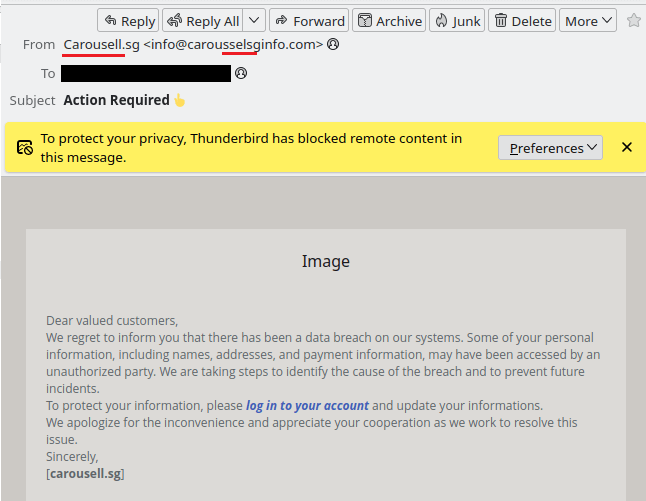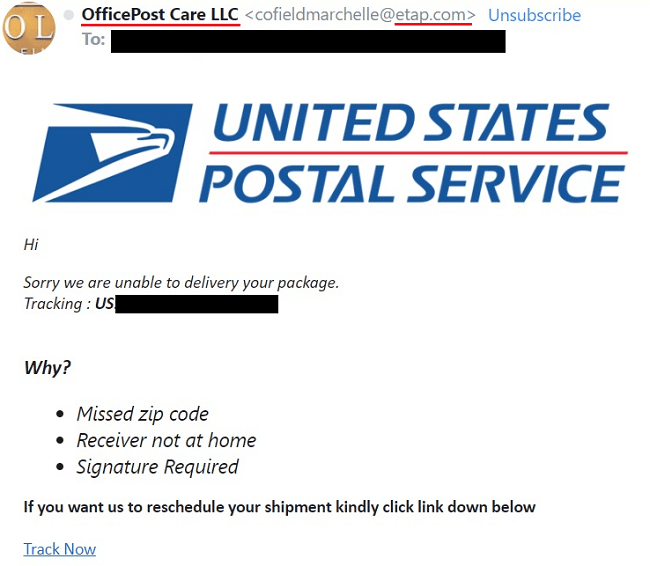What is “Asia Pacific Lottery” Email Spam
Subject: Re:2024 WINNING EMAIL LOTTERY PROMOTION PRIZE NOTIFICATION!!
FROM THE DESK OF THE PRESIDENT,ASIA PACIFIC LOTTERY ASSOCIATION LIMITED,ASIA PACIFIC REGIONAL OFFICE,JAKARTA INDONESIA. 2024 WINNING EMAIL LOTTERY PROMOTION PRIZE NOTIFICATION!! Congratulations To The Beneficiary of this email!! Move this message to your inbox before replying in order to respond back to you. It's our pleasure to inform you that your email address has won the lottery, ASIA PACIFIC LOTTERY 9th edition season international online lottery promotion. All the Winner addresses were selected randomly from the World Wide Websites through a computer draw system and extracted from over 200,000 email addresses & official addresses, that are listed online from Asia, Australia, New Zealand, Europe, North and South America, Middle East and Africa. This is part of our yearly international program. You have therefore been approved for a lump sum payment of US$ 1,000,000 as a cash prize among some lucky other 50 winners individuals on the 2nd category ( One Million United States Dollars Only ) cash prize winning. These are your Reference to your winnings Ref: ACLC/9420X2/68Batch: 074/05/ZY369Ticket number:56475600545 188Lucky Numbers: 05,06,17,20,28,42(Bonus33) Note, This Lottery was promoted and sponsored by some conglomerates of some multinational companies as part of their social responsibility to the citizens in the communities where they have operational bases. You don't have to purchase a ticket to enter or play the lottery, as this are ticket free. The promotion was drawn online through a computer balloting system which your email address luckily on randomly was selected. To file your prize claim, You are advised to fill all the listed information below and submit to the coordinator on this given email: adityasukarno36@gmail.com to enable our coordinator below contact you with further information and direction on how to redeem your cash prize. Name Coordinator: Mr.Sukarno AdityaE-mail adityasukarno36@gmail.comInformation to be filled. 1.Name in full---------2.Address----------------3.Nationality-----------------4.Copy of your International passport or i'd card------------------5.Occupation------6.Sex -------------7.Phone/Fax-----------8.Present Country------ In order to avoid any unnecessary delays and complications, please remember to quote your reference numbers in all correspondences with us, Furthermore, should there be any change of address, please do inform our Coordinator as soon as possible. For security measures, you are advised to keep your winning announcement confidential until your claim is processed and your prize remitted to you in whatever manner, This is part of our precautionary measures to avoid a double claimants or unwarranted claims as has happened in the past. Take note as We shall not be responsible for any prize lost, if claimed by unknown persons. Please be warned. Warning!! You are expected to claim your prize immediately on receiving the notification, and not exceeded more than 30 days. Any prize not claimed between these days will be returned to HER MAJESTYS DEPARTMENT OF THE TREASURY. CONGRATULATIONS!! Once again from all members and staff of the Asia Pacific Lottery Association Limited and thank you for being a part of our International Promotion program. We wish you continued good fortunes. Yours Faithfully,Announcer!!Dr.Guang BendillyOn behalfs of the Asia International Lottery OrganizationAsia Pacific OfficeJakarta Indonesia.
Asia Pacific Lottery email spam is a type of scam where recipients are informed that they have won a large sum of money in a lottery. The emails typically claim that the recipient’s email address was randomly selected as the winner, and they are instructed to provide personal information or pay a fee in order to claim their prize. These emails are often designed to appear legitimate, with official-looking logos and branding to deceive recipients into believing that they have actually won a lottery.
Asia Pacific Lottery spam campaigns can infect computers in several ways. One common method is through email attachments or links that, when clicked, can download malware onto the recipient’s device. This malware can then steal sensitive information, such as bank account details or passwords, and use it for malicious purposes. Additionally, interacting with Asia Pacific Lottery email scams can also lead to further phishing attempts, where scammers attempt to trick recipients into providing even more personal information or money. It is important to be cautious and vigilant when receiving unsolicited emails claiming that you have won a lottery, as they are likely part of a scam designed to steal your information and money.

How to stop email spam like “Asia Pacific Lottery”
You can use an anti-spam filter which will block most known sources of spam before they even reach your inbox. MailWasher is a program you may try. It filters spam and lets you preview emails on a server without downloading them onto your computer. MailWasher has customizable spam filters, uses bayesian filtering and works with all major email programs: Outlook, Outlook Express, Thunderbird, GMail, etc.
Types of spam email
Spam email messages can be approximately divided into three categories: those that prompt you to download and run something, those that ask for your personal data, and those asking you to make payments. Let’s take a closer look at each one so we can better protect ourselves from these scams.
-
Emails with attachments
In the first case the email contains an attachment which it prompts you to open. Those attachments may consist of executable files or they may be Microsoft Word or Excel documents containing malicious macro scripts. Once you launch the executable file or allow the document to run its macros, malware downloads onto your device and wreaks all kinds of havoc with it.
The malware may range from adware showing extra ads on your browsers to ransomware that encrypts your files and aks for payment to decrypt them.
-
Phishing emails
The second type of spam (phishing emails) try to trick you into entering your name, logins, passwords, credit card details, etc. on what you think are legitimate and respectable websites.
Those emails usually pretend to be messages from well-known websites that you are probably registered on, and prompt you to follow a link to their site for some reason (for example, there is something wrong with your account). The provided link leads to fake site of course, and the data you enter ends up in the hands of cybercriminals.
-
Advance-fee scam and sextortion scam emails
Finally there are the emails urging people make payments. These can be further divided into two types: the first type, asking people to invest into something, to pay some money now and get back much more later (the advance-fee scam); the second one, scaring people into paying to prevent something bad from happening.
An example of the first one is the well-known Nigerian Prince email. A example of the second is sextortion scam: emails that claim that the email author has access to the victims’s web cam and has the victims intimate videos, which the criminal threatens to publish unless paid off.

How to find out that the email is scam

- Check the sender’s address – if the address doesn’t match up with what you expect from that company, then it’s very likely that the email is scam. Be aware though that the sender address can be faked, so if the address looks legitimate it is not guaranteed that the email is legit.
- Look for spelling and grammar mistakes and weird phrasing – real emails from reputable companies are far less likely to have those.
- Watch for urgent requests – legitimate companies will never ask customers for sensitive information such as credit card numbers via email, so if an email suddenly asks for urgent action like requesting payment details within few hours, chances are high this could potentially be a scam attempt.
How to protect yourself from email scam
- Use an email filtering service – email filtering services like MailWasher Pro allow you to filter out unwanted messages before they reach your inbox. These services use sophisticated algorithms to identify suspicious content in incoming emails and block them automatically so that only legitimate messages make it through the filter.
- Avoid clicking on suspicious links – if you receive an email with a link that looks suspicious, do not click on it! Even if the sender appears familiar, chances are high that the link is malicious and could lead you down a path of malware infection or identity theft. It is best not to open any unknown links at all.
- Don’t respond directly – never reply directly to spam emails as this will confirm for spammers that your address is active which may result in more unsolicited mail being sent your way. Instead, mark these messages as “Spam” within your email client/service provider so that their filters can better detect similar types of mail next time.
- Keep software up-to-date – make sure all software installed onto devices such as computers and smartphones is kept up-to date with latest security patches released by developers; this helps reduce risk posed by cyber criminals who exploit vulnerabilities found in outdated versions of programs including email clients.
- Use anti virus protection – install reputable antivirus solutions onto any device receiving emails; most modern day anti viruses come equipped with advanced features such as real time scanning which help detect potential threats immediately upon opening files attached to emails.
